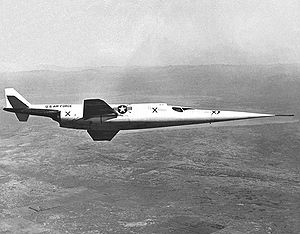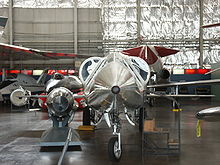Douglas X-3 Stiletto Video - Newsreel
|
|
Douglas X-3 Stiletto

Role: Experimental
Manufacturer: Douglas
First flight: 15 October 1952
Retired: 23 May 1956
Primary users: United States Air Force
NACA
Number built: 1
The Douglas X-3 Stiletto was a 1950s United States experimental jet aircraft with a slender fuselage and a long tapered nose, manufactured by the Douglas Aircraft Company. Its primary mission was to investigate the design features of an aircraft suitable for sustained supersonic speeds, which included the first use of titanium in major airframe components. It was, however, seriously underpowered for its purpose and could not even exceed Mach 1 in level flight. Though the research aircraft was a disappointment, Lockheed designers used data from the X-3 tests for the F-104 Starfighter which used a similar wing design in a successful Mach 2 fighter.
Design and development
The Douglas X-3 Stiletto was the sleekest of the early experimental aircraft, but its research accomplishments were not those originally planned. The goal of the aircraft was ambitious - it was to take off from the ground under its own power, climb to high altitude, maintain a sustained cruise speed of Mach 2, then land under its own power. The aircraft was also to test the feasibility of low-aspect ratio wings, and the large-scale use of titanium in aircraft structures.
Construction of a pair of X-3s was approved on 30 June 1949. During development, the X-3's planned Westinghouse J46 engines were unable to meet the thrust, size and weight requirements, so lower-thrust Westinghouse J34 turbojets were substituted, producing only 4,900 lbf (21.8 kN) of thrust with afterburner rather than the planned 7,000 lbf (31.3 kN). The first aircraft was completed and delivered to Edwards Air Force Base, California, on 11 September 1952.
The X-3 featured an unusual, rakish shape of a long cylindrical fuselage with tiny trapezoidal wings. One of the design considerations was to create the smallest and "thinnest" shape possible in order to achieve a streamlined planform. The extended nose was to allow for the provision of test equipment while the semi-buried cockpit and windscreen was designed to alleviate the effects of "thermal thicket" conditions. The low aspect ratio, unswept wings were designed for high speed and later the Lockheed design team used data from the X-3 tests for the similar F-104 Starfighter wing design. Due to both engine and airframe problems, the partially completed second aircraft was cancelled, and its components were used for spare parts.
Operational history
The first X-3 "hop" was made on 15 October 1952, by Douglas test pilot William Bridgeman. During a high-speed taxi test, Bridgeman lifted the X-3 off the ground and flew it about 1 mi (1.6 km) before settling back onto the lakebed. The official first flight was made by Bridgeman on 20 October, and lasted about 20 minutes. He made a total of 26 flights (counting the hop) by the end of the Douglas tests in December 1953. These showed that the X-3 was severely underpowered and difficult to control. Its takeoff speed was an unusually high 260 kn (482 km/h). More seriously, the X-3 did not approach its planned top speed. Its first supersonic flight required that the airplane make a 15° dive to reach Mach 1.1. The X-3's fastest flight, made on 28 July 1953, reached Mach 1.208 in a 30° dive. A plan to re-engine the X-3 with rocket motors was considered but eventually dropped.
With the completion of the contractor test program in December 1953, the X-3 was delivered to the United States Air Force. The poor performance of the X-3 meant only an abbreviated program would be made, to gain experience with low-aspect ratio wings. Lieutenant Colonel Frank Everest and Major Chuck Yeager each made three flights. Although flown by Air Force pilots, these were counted as NACA flights. With the last flight by Yeager in July 1954, NACA made plans for a limited series of research flights with the X-3. The initial flights looked at longitudinal stability and control, wing and tail loads, and pressure distribution.
NACA pilot Joseph A. Walker made his pilot checkout flight in the X-3 on 23 August 1954, then conducted eight research flights in September and October. By late October, the research program was expanded to include lateral and directional stability tests. In these tests, the X-3 was abruptly rolled at transonic and supersonic speeds, with the rudder kept centered. Despite its shortcomings, the X-3 was ideal for these tests. The mass of its engines, fuel and structure was concentrated in its long, narrow fuselage, while its wings were short and stubby. As a result, the X-3 was "loaded" along its fuselage, rather than its wings. This was typical of the fighter aircraft then in development or testing.
These tests would lead to the X-3's most significant flight, and the near-loss of the aircraft. On 27 October 1954, Walker made an abrupt left roll at Mach 0.92 and an altitude of 30,000 ft (9,144 m). The X-3 rolled as expected, but also pitched up 20° and yawed 16°. The aircraft gyrated for five seconds before Walker was able to get it back under control. He then set up for the next test point. Walker put the X-3 into a dive, accelerating to Mach 1.154 at 32,356 ft (9,862 m), where he made an abrupt left roll. The aircraft pitched down and recorded an acceleration of -6.7 g (-66 m/s²), then pitched upward to +7 g (69 m/s²). At the same time, the X-3 side-slipped, resulting in a loading of 2 g (20 m/s²). Walker managed to bring the X-3 under control and successfully landed.

Picture - X-3 Stiletto in the R&D hangar of the National Museum of the United States Air Force
The post-flight examination showed the fuselage had been subjected to its maximum load limit. Had the acceleration been higher, the aircraft could have broken up. Walker and the X-3 had experienced "roll inertia coupling," in which a maneuver in one axis will cause an uncommanded maneuver in one or two others. At the same time, several F-100 Super Sabres were involved in similar incidents. A research program was started by NACA to understand the problem and find solutions.
For the X-3, the roll coupling flight was the high point of its history. The aircraft was grounded for nearly a year after the flight, and never again explored its roll stability and control boundaries. Walker made another 10 flights between 20 September 1955 and the last on 23 May 1956. The aircraft was subsequently retired to the U.S. Air Force Museum. Although the X-3 never met its intention of providing aerodynamic data in Mach 2 cruise, its short service was of value. It showed the dangers of roll inertia coupling, and provided early flight test data on the phenomena. Its wing planform was used in the Lockheed F-104 Starfighter, and it was one of the first aircraft to use titanium. Finally, the X-3's very high takeoff and landing speeds required improvements in tire technology.
Production
Two aircraft were ordered, but only one was built. It made 51 flights.
Survivors
The sole X-3 was transferred in 1956 to the National Museum of the United States Air Force at Wright-Patterson Air Force Base, Ohio. As of 2008 it is on display in the Museum's Research & Development Gallery.
Specifications (X-3)
General characteristics
Crew: 1
Length: 66 ft 9 in (20.3 m)
Wingspan: 22 ft 8 in (6.9 m)
Height: 12 ft 6 in (3.8 m)
Wing area: 166.5 ft² (15.47 m²)
Empty weight: 16,120 lb (7,310 kg)
Max takeoff weight: 23,840 lb (10,810 kg)
Powerplant: 2x— Westinghouse J34 afterburning turbojet, 3,370 lbf, 4,850 lbf with afterburning (15.0 kN, 21.6 kN with afterburning) each
Performance
Maximum speed: 700 mph (1,125 km/h)
Range: 497 mi (800 km)
Service ceiling: 38,000 ft (11,600 m)
Thrust/weight: 0.40
Related development
F-104 Starfighter
Comparable aircraft
Bristol 188
Bibliography
Global Aircraft: X-3 Stiletto
NASA-Dryden X-3 Fact Sheet
National Museum of the U.S. Air Force page on the X-3
Pace, Steve. X-Fighters: USAF Experimental and Prototype Fighters, XP-59 to YF-23. Osceola, Wisconsin: Motorbooks International, 1991. ISBN 0-87938-540-5.
United States Air Force Museum Guidebook. Wright-Patterson AFB, Ohio: Air Force Association, 1975 edition.
Winchester, Jim. "Douglas X-3." Concept Aircraft: Prototypes, X-Planes and Experimental Aircraft. Kent, UK: Grange Books plc, 2005. ISBN 1-84013-309-2.
Living Warbirds: The best warbirds DVD series.
Source: WikiPedia